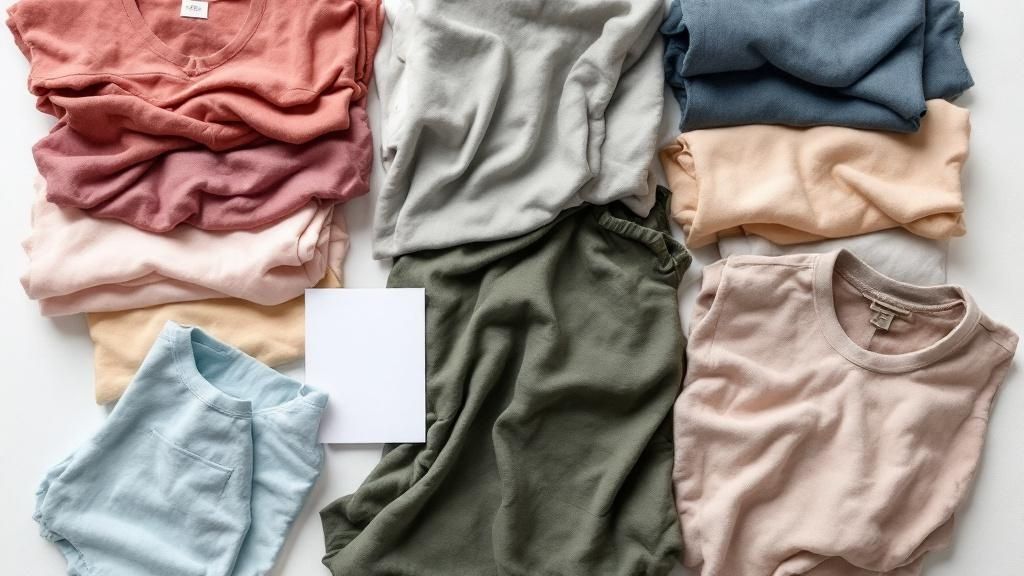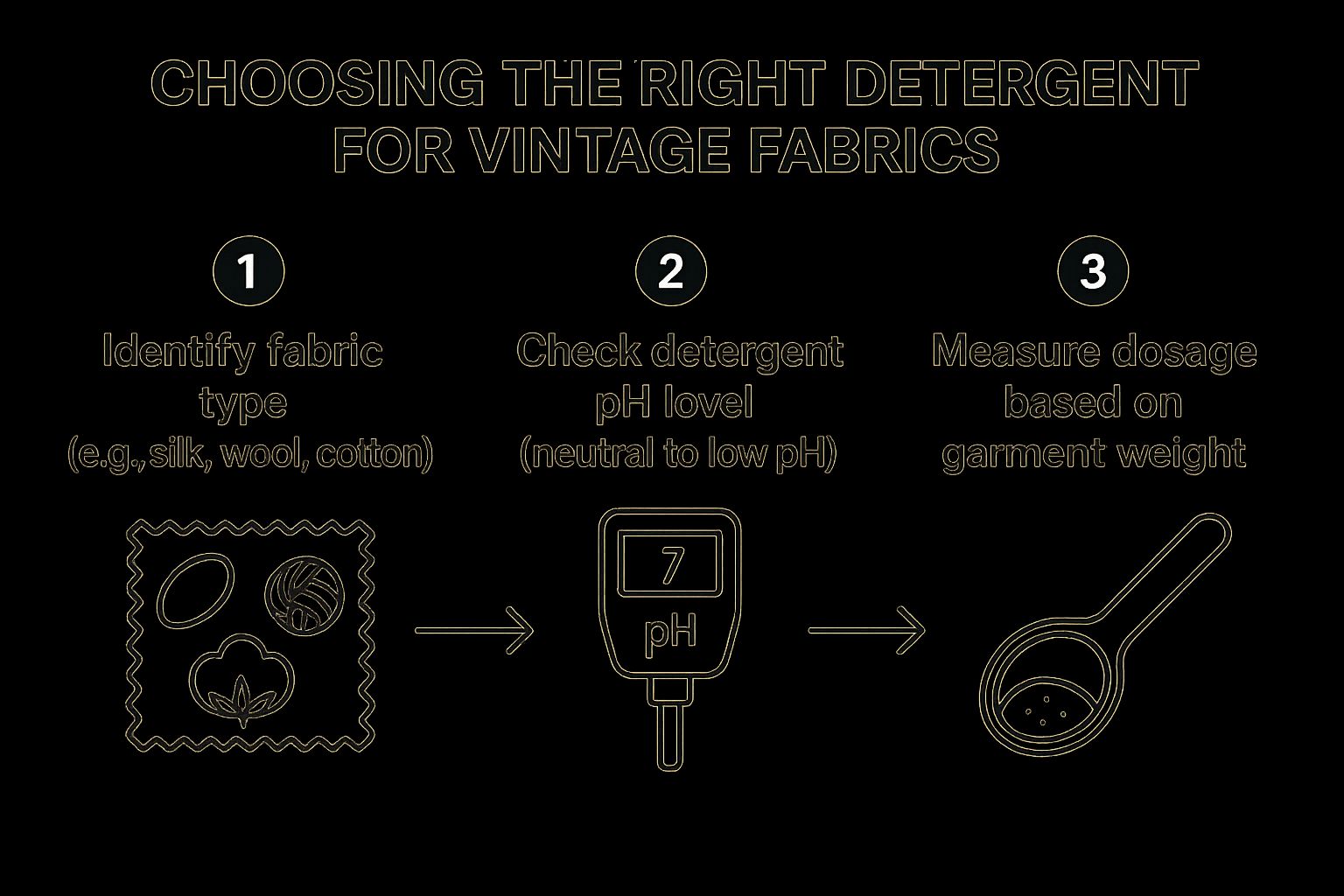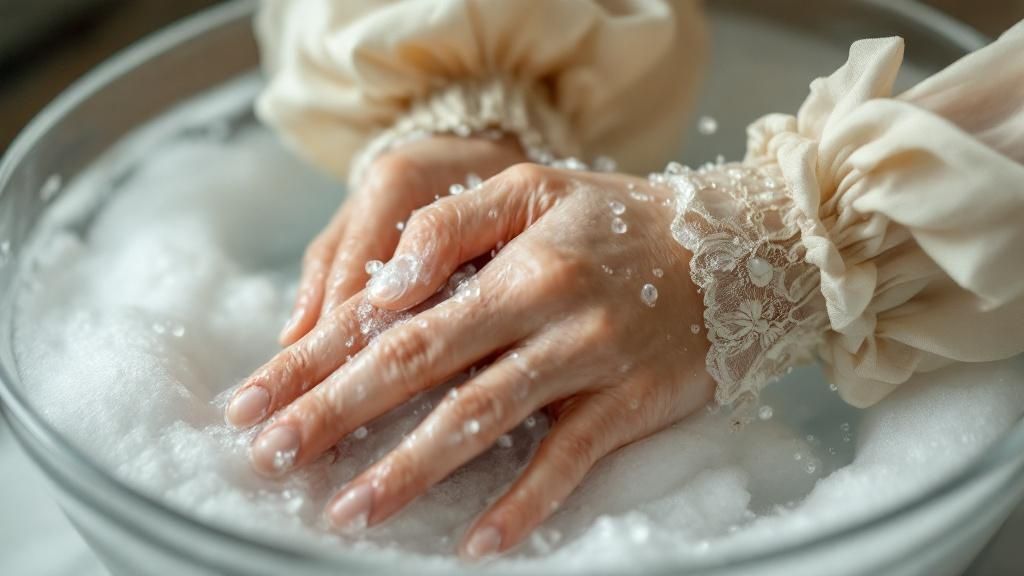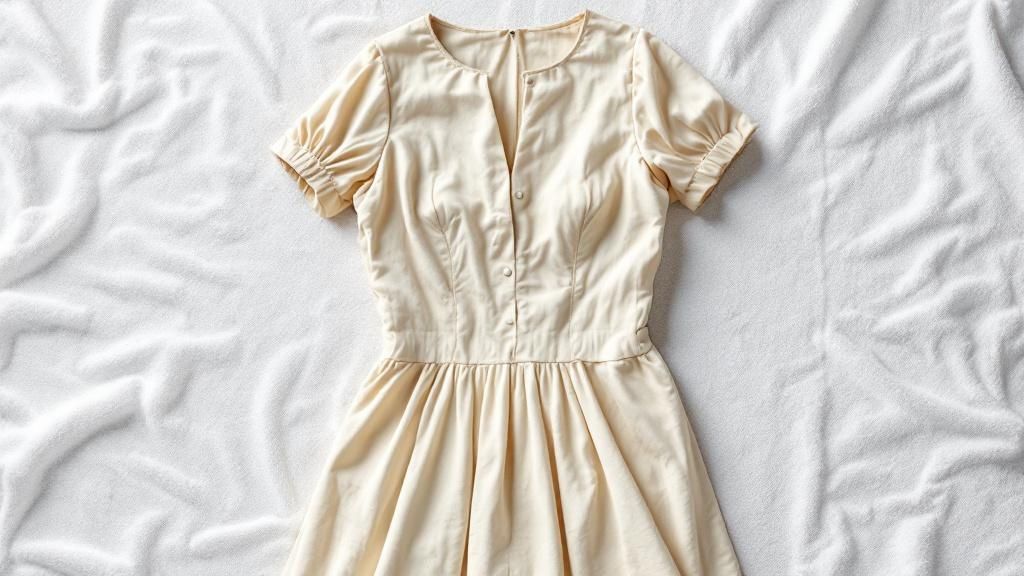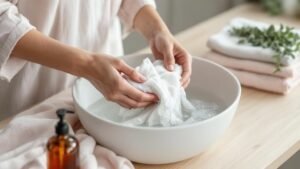
How to Wash Vintage Clothing: Tips to Keep It Beautiful
When you’re learning how to handle vintage clothing, it’s all about finding that sweet spot between a thorough clean and careful preservation. The secret? It always starts with assessing the fabric's condition, choosing the absolute mildest cleaning method you can, and sticking to cold water. This simple step helps you dodge the most common disasters, like shrinkage or color bleeding.
Whatever you do, don't just toss a vintage piece into a modern washing machine and hope for the best. Hand washing is almost always your safest bet.
The Gentle Art of Washing Vintage Clothing
Before that treasured garment even sees a drop of water, you have to understand its unique history and what it can handle. This isn't just about scrubbing away a bit of grime; it's about being a custodian for a piece of the past. Unlike the tough, engineered textiles of today, vintage fabrics—especially those delicate silks, old-school wools, and early rayons—are incredibly fragile and can't stand up to a rough wash.
One wrong move, and the damage can be permanent. We're talking about real risks, from catastrophic color bleeds that ruin the entire piece to fiber shrinkage that warps its shape forever. Getting this part right means treating your vintage finds with the respect they’ve earned, setting you up for a beautiful result.
Why Preservation Is Everything
With vintage, your first thought should always be preservation. A clean garment is the goal, but not at the cost of its integrity. Historically, fabrics made from natural fibers like silk, wool, and cotton are far more vulnerable than anything we produce today. The growing second-hand market has put a spotlight on just how vital proper garment care is, a trend you can read more about on gminsights.com.
Experts agree that water temperature is a make-or-break factor. Using cold water, around 20°C (or 68°F), drastically cuts down the risk of both shrinkage and color bleeding—the two quickest ways to destroy a vintage piece.
A Note on Fragility: Textile conservationists all follow one golden rule: test a fabric’s strength before you even think about washing it. If it feels brittle, shows any signs of tearing, or has a stubborn mildew smell, it might be too fragile for you to handle at home. Knowing your limits is just as important as knowing the right technique.
Before you begin, a quick assessment can save you a world of trouble. Here's a simple guide to get you started.
Vintage Fabric Wash Method Quick Guide
This table is your first stop for deciding how to approach a wash. It’s not exhaustive, but it covers the most common fabrics you'll encounter and steers you in the safest direction.
| Fabric Type | Recommended First Action | Key Precaution |
|---|---|---|
| Cotton & Linen | Hand wash in cold water | Prone to color bleeding, especially if brightly colored. Always spot-test first. |
| Silk | Hand wash in cold water with a pH-neutral soap | Extremely sensitive to temperature changes and harsh chemicals. Never wring or twist. |
| Wool | Hand wash in cool water; very minimal agitation | Can shrink or "felt" easily. Lay flat to dry away from direct heat or sunlight. |
| Rayon (early types) | Spot clean or professional clean if unsure | Early rayon is notoriously weak when wet and can tear or stretch out of shape. |
| Synthetics (Nylon, Polyester) | Gentle machine wash on a cold, delicate cycle | Generally more durable, but zippers or embellishments on the garment can snag. |
Remember, when in doubt, always opt for the most gentle method possible. You can always try a more intensive cleaning later, but you can never undo damage.
Creating the Perfect Cleaning Canvas
The objective here is a powerful clean with zero interference. It's why Active Scent’s Odorless Detergent was meticulously formulated to deliver a deep, effective clean — without any competing scent. It gets rid of deep-set grime and neutralizes those musty "old clothes" smells, but without adding any fragrance of its own.
This process creates the ultimate neutral base, created to harmonize perfectly with a line of luxury-scented softeners. It ensures the item is completely clean and ready for that final, luxurious step: infusing it with a signature scent. Starting with an odorless clean allows a sophisticated fragrance, like our “Pat & Shouli,” to truly stand out without any interference. You’re not just doing laundry; you’re curating a sensory experience.
Your Pre-Wash Assessment Checklist
Before a single drop of water touches that precious find, you need to play detective. This is the most critical part of caring for vintage clothing, the moment that separates a beautiful revival from a heartbreaking mistake. Forget the laundry room for a minute and think of yourself as a textile historian, carefully examining every inch for clues about the garment's life and its hidden weaknesses.
First, lay the piece out in good, natural light and just look. What do you see? You’re searching for any sign of distress that a wash could turn into a disaster.
- Moth Holes: Look for tiny, scattered, irregular holes. They’re a tell-tale sign, especially on natural fibers like wool, cashmere, and silk.
- Brittle Threads: Give a seam a very gentle tug. If the threads feel dry and snap with almost no pressure, the garment’s structure is too fragile to handle washing.
- Fabric Rot or “Shattering”: This is the silent killer of old silks. A garment can look perfectly fine, but the moment it hits water, it disintegrates. If the fabric feels almost like paper or tears with the slightest pull, it’s a candidate for preservation, not washing.
This first pass tells you if you can even proceed. If you find any major structural damage, it’s time to step back and consult a professional restorer.
The Fabric and Color Test
With no care tag to guide you, your sense of touch is your best tool. Rub the fabric between your fingers. Does it feel cool and slick like silk? Crisp and dry like cotton? Maybe a little scratchy with a bit of spring, like wool? Synthetics from past eras, like early polyester, often have a specific, almost artificial feel that’s different from natural fibers.
Once you have a hunch about the fabric, you have to test the color. This is non-negotiable. I can’t tell you how many vibrant 1950s cotton dresses I’ve seen turn into a muddy mess because this step was skipped.
Pro Tip for Color Testing: Find a spot that will never be seen—an inside seam, the back of a hem, or behind a button placket. Dip a Q-tip in cool water and gently rub it on the fabric. Check the cotton. If even a hint of color has transferred, the dyes are unstable. Stop right there. Immersing this piece in water will cause the colors to bleed everywhere.
If the fabric holds its color, you’re one step closer. That simple five-second test can save a multi-colored masterpiece.
The Final Checks for Stains and Smells
Now, get up close and personal with any specific issues. Can you gently brush away surface dust, or are you looking at a set-in stain that needs a more targeted approach? A faint water spot from decades ago is one thing; a dark, oily mark is another entirely. Take a mental inventory of every spot that will need attention before the main wash.
Finally, trust your nose. The smell of a garment tells a story.
- A simple musty odor is completely normal for a piece that’s been in storage. This is the smell of time, and it will almost always wash out.
- A sharp, persistent mildew smell is a huge red flag. This isn't just mustiness; it means mold spores have likely taken root deep in the fibers, potentially causing decay you can't even see yet.
Going through this checklist isn't about creating more work; it's about making a smart decision. By assessing the fabric's integrity, color stability, stains, and scent, you can confidently decide how to proceed, ensuring your vintage treasure emerges from its bath clean, intact, and ready for its next chapter.
Hand Washing: The Fail-Safe Method for Delicate Garments
For most vintage clothing, especially pieces made before the 1960s, hand washing isn't just an option—it's the only truly safe method. A machine's agitation, even on a delicate cycle, can be far too aggressive for aged fibers. Hand washing gives you complete control, allowing you to clean the garment with the tactile care it needs to survive for another generation.
Think of it less as a chore and more as a preservation ritual. The goal is to gently coax dirt and odors out of the fabric, not to scrub them into submission. This hands-on approach is your best defense against the stretching, tearing, and dreaded color bleed you spot-tested for earlier.
With Active Scent, LAUNDRY NEVER SMELLED SO GOOD! With Active Scent, cleaning is transformed from a mundane task into a sensory experience. Each product delivers a spark of joy, a touch of boldness, and a wave of confidence, all wrapped in powerful, EXCEPTIONAL PRODUCT.
Preparing Your Wash Basin
First, choose your vessel. A clean sink, bathtub, or a dedicated wash basin all work perfectly. The key is making sure it's spotless—any leftover residue from harsh cleaning chemicals can easily damage delicate fabrics.
Fill your basin with cold or lukewarm water. Never use hot water, as it's the primary culprit for both shrinkage and fading in vintage textiles. You only need enough water to fully submerge the garment without it feeling cramped.
Next, it’s time for the detergent. It's crucial to select a powerful but gentle, pH-neutral formula. Our Odorless Detergent is ideal for this, providing a deep clean without leaving any competing scent. This creates the perfect neutral canvas. Always add the detergent to the water and swish it around to dissolve completely before you introduce the garment.
The Gentle Soaking Process
Gently place your garment into the soapy water, pressing it down until it's fully saturated. Let it soak, but for no more than 20-30 minutes. A prolonged soak doesn't necessarily mean a cleaner garment and can actually weaken the fibers over time.
To work the soap through the fabric, use a gentle squeezing or pulsing motion with your hands. Just imagine you're pressing a sponge. For exceptionally delicate items like silk, you can find more specific advice in our guide on how to wash silk garments.
Crucial Handling Tip: Never, ever wring, twist, or scrub vintage fabric. The stress of these motions is more than enough to snap aged threads or permanently stretch the material out of shape. Gentle squeezing is all you need.
Once the short soak is over, drain the soapy water and refill your basin with clean, cool water to begin the rinse.
Rinsing and Adding Fragrance
Rinsing thoroughly is just as important as washing. Any soap residue left behind can cause the fibers to become yellow and brittle over time.
Gently squeeze the garment in the clean water, drain, and repeat the process until the water runs completely clear and free of suds. This might take two or three rinses, but it’s worth the effort.
This final rinse is the perfect opportunity to elevate the entire experience. This is where you can add a luxury-scented softener to imbue the piece with a unique, lasting fragrance. You’re not just cleaning; you're curating the garment's next chapter and truly making it your own.
The Art of Drying and Pressing Vintage Pieces
You’ve carefully washed your vintage treasure, but the work isn’t quite done. How you dry and press a garment is just as critical as the wash itself. Honestly, a modern machine dryer can erase decades of history in a single, aggressive cycle. The intense heat and tumbling are simply too much for aged fibers, causing irreversible shrinkage, tears, and distortion.
The moment you lift the garment from the water is crucial. First rule: never, ever twist or wring it out. That single motion puts an incredible amount of stress on old seams and can easily tear fragile threads or stretch the fabric out of shape for good. I always make sure to support the garment from underneath as I lift it, letting the weight of the water distribute evenly.
The Collector's Secret: The Towel Roll
A technique I swear by—and one you’ll hear from any serious collector—is the towel-rolling method. It’s a beautifully simple and gentle way to pull out a surprising amount of moisture without causing any harm.
- First, lay a big, clean, fluffy towel down on a flat surface.
- Carefully place your wet garment on top, smoothing out any major creases.
- Now, starting from one end, gently roll the towel and the garment up together, almost like a jelly roll.
- Press down softly on the rolled-up towel. You don’t need a lot of force; just let the towel do its job of absorbing the water.
- Finally, unroll everything and lift out your now-damp (not soaking) piece.
This little ritual makes a huge difference, dramatically cutting down the drying time while keeping the delicate structure of your piece perfectly intact. For anything fragile like early rayon or silk, this step is non-negotiable.
A Word of Warning on Sunlight: While fresh air is your friend, direct sun is the enemy of vintage textiles. The sun’s UV rays will bleach vibrant colors with surprising speed and can make natural fibers, especially silk and wool, brittle over time. Always find a spot with great air circulation but keep your treasures far away from direct sunlight or heat sources like radiators.
The Final Touches: Drying and Pressing
For most vintage items, laying them flat to air-dry is the gold standard. This simple act prevents gravity from stretching out the shoulders or distorting the garment's intended shape. A mesh drying rack is perfect, but laying the item on a fresh, dry towel works just as well. Just be sure to flip it over every few hours to help it dry evenly.
Once the piece is completely dry, you can think about pressing. The key here is low heat and protection. Always start with your iron on the lowest possible setting for the fabric type.
To create a protective barrier, I always use a press cloth. It’s nothing fancy—a clean piece of cotton, like an old pillowcase or a scrap of muslin, placed between the iron and your vintage piece. This prevents that dreaded "iron shine" and protects delicate surfaces. And a final pro tip: for anything with prints, beading, or a textured weave, always iron on the reverse side. This protects all those beautiful details from the direct heat of the iron.
This careful finishing touch is what ensures your beautifully cleaned garment looks pristine, ready to be worn or stored with care.
Infusing Your Vintage Finds With Luxury Scents
Getting your vintage piece clean is only half the battle. The final, truly transformative step is to elevate its scent from merely clean to utterly magnificent. This is where laundry becomes an act of curation, turning a restored garment into a personal, unforgettable statement.
The secret to achieving a sophisticated final fragrance is starting with a perfectly neutral base. Using a powerful, odorless detergent is the ideal first step, creating a 'blank canvas' by neutralizing any lingering mustiness without leaving a conflicting scent. Think of it as priming a canvas before painting; it ensures the true colors—or in this case, scents—can shine.
Building a Complex Olfactory Statement
With your garment impeccably clean and scent-free, you can now introduce a fragrance that complements its history and style. This is where a luxury fabric softener comes in, not just to soften fibers, but to impart a complex, layered scent profile. You have the power to choose an aroma that reflects your personal taste and gives the vintage piece a new, modern identity.
Imagine elevating your garment with a bold, mysterious, and hypnotic scent. This is the moment to move beyond basic laundry smells and embrace the world of fine perfumery.
The Power of a Signature Scent
Choosing the right fragrance is like choosing the perfect accessory—it completes the entire experience and leaves a lasting impression. A scent with genuine depth and character can turn your restored vintage dress or silk blouse into a true conversation piece.
For instance, consider a fragrance built with intention, like Active Scent’s “Pat & Shouli.” This is not your average softener. A Bold Tribute to the Dark Side of French Perfumery, it is imprinted in the spirit of iconic French houses like Dior, Mugler, or Le Labo. This fragrance is an unforgettable olfactory statement that doesn’t just tell a story; it leaves a mark.
At Active Scent, our lead Perfumer and Aroma Designer have masterfully blended shadows and light, crafting scents that range from deeply enigmatic to refreshingly vibrant. Drawing inspiration from the luxurious complexity of raw materials, we use premium, avant-garde, and sometimes surprising exotic elements to olfactively capture the essence of contemporary individuality. Each fragrance is composed of both natural and ethically sourced ingredients, offering a refined and distinguished sensory experience.
The composition is a journey in itself:
- Deep, earthy patchouli fuses with the burning radiance of amber.
- Fiery pimento berries ignite the composition with spice and warmth.
- The fragrance is enveloped in the creamy depth of tonka bean and rich guaiac wood.
- A hint of styrax adds a final, smoky elegance.
By infusing your vintage clothing with such a carefully crafted aroma, you’re doing more than just washing it. You are merging the past with the present, creating a piece that is not only visually stunning but also olfactively captivating.
To learn more about pairing powerful cleaning with exceptional fragrance, you can find helpful information in our guide to the best smelling luxury laundry detergent. This final touch ensures your vintage find feels entirely, uniquely yours.
Common Questions About Washing Vintage Clothing
Even with the best intentions, questions are bound to pop up. Learning to care for vintage clothing is a journey, and troubleshooting is a skill every collector hones over time. Knowing how to handle the unexpected is what gives you the confidence to protect these one-of-a-kind pieces.
This is where we tackle the most common concerns I hear, from odors that just won't quit to knowing when to step back and let a professional take over. Let's dive into the real-world advice that will help you master the art of vintage care.
How Can I Remove Stubborn Musty or Smoke Odors?
Some scents cling to a garment's past. That deep-set mustiness or the ghost of smoke from a bygone era often needs more than a simple wash to be banished. For these tougher cases, a gentle pre-soak is your best friend.
Try a simple solution of one part plain white vinegar to four parts cold water. Let the garment rest in this bath for about 30 minutes before you move on to your hand wash. The vinegar is brilliant at neutralizing the alkaline molecules that cause those stubborn smells.
After washing, the final rinse is your secret weapon. Using a luxury-scented softener isn't just about softening fibers; it’s an act of transformation. A complex, hypnotic fragrance like Active Scent's "Pat & Shouli" masterfully replaces any lingering unwanted notes. It’s the final touch that elevates a piece from merely clean to unforgettably fragrant.
Is It Ever Safe to Use a Washing Machine for Vintage Items?
While hand washing is the undisputed gold standard, there are very rare exceptions. This is a path you should only walk with extreme caution. A machine should only be considered for exceptionally sturdy fabrics, typically from the 1960s or later—think robust cottons and resilient polyesters.
If you believe your item is a candidate, you must take every precaution:
- Always use a mesh laundry bag. This is non-negotiable. It shields the garment from snagging on the machine's drum.
- Select the most delicate cycle available. Use only cold water and the absolute lowest spin setting to minimize stress.
- Wash the item completely alone. You don't want heavier, modern clothes to batter your delicate vintage piece during the cycle.
When in doubt, always default to hand washing. The risk of irreversible damage from a machine is simply too high for most vintage clothing. It's a gamble that's rarely worth taking with a one-of-a-kind piece.
To ensure you're protecting all your garments, not just vintage, you might find our guide on the best smelling laundry detergent for sensitive skin helpful. Gentle formulas benefit every fabric in your closet.
What Stains Should I Never Try to Remove Myself?
Knowing your limits is a critical part of preservation. While you can absolutely tackle many common stains at home, some are best left to a professional who specializes in restoring historic textiles.
Trying to remove these stains without expert knowledge can cause permanent damage—color loss, thinning fabric, or setting the stain forever. The ones to leave alone are:
- Deeply set ink stains
- Rust spots, often from old metal hangers or fasteners
- Certain oil-based stains, especially on delicate fabrics like silk or rayon
When Should I Choose Dry Cleaning Over Washing?
Water isn't always the answer. For certain pieces, dry cleaning is the only safe method to preserve their structure and soul.
Water can completely warp tailored construction, ruin delicate beadwork, and cause linings to shrink at a different rate than the outer fabric. Always take items like structured wool coats, velvet pieces, or garments with complex linings and embellishments to a trusted dry cleaner. Be sure to point out that the item is vintage so they know to use the gentlest solvents and techniques.
At Active Scent, we believe caring for your clothes should be an exceptional experience. Escape the ordinary and let yourself be seduced by luxury fragrances inspired by iconic perfume houses.
Discover the full collection and transform your laundry ritual.

